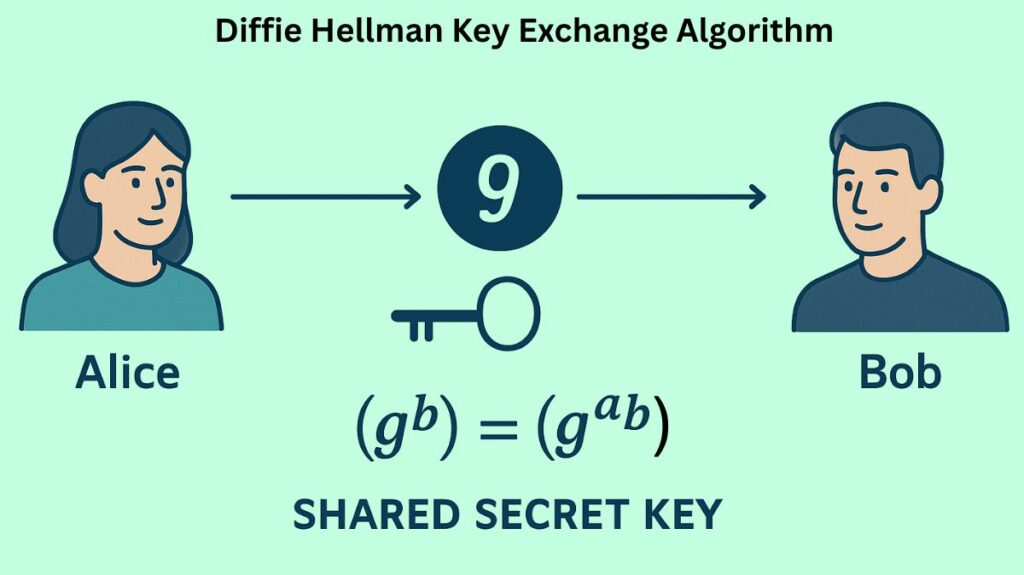What is Diffie Hellman Key Exchange Algorithm

Even in the presence of eavesdroppers, two parties can safely establish a shared secret cryptographic key via an unprotected, public communication channel using the Diffie Hellman Key Exchange Algorithm technique, also referred to as exponential key exchange.
Whitfield Diffie and Martin Hellman first introduced this ground-breaking technique in 1976. It is a cornerstone of contemporary network security.
You can also read Applications Of AES Advanced Encryption Standard In Network
Key Characteristics and Role
- Key Exchange, Not Encryption: The DH algorithm does not encrypt bulk data; rather, it just generates a shared secret key. The problem of safely sending a symmetric key to both ends of a communication link is resolved by it.
- Asymmetrical/Symmetrical: DH falls within the category of asymmetric key systems or asymmetrical algorithms. But the keying material it produces is a shared secret key, also known as a symmetrical key.
- Data Protection: For effective bulk data protection, quick symmetrical encryption algorithms like Triple DES (3DES) or Advanced Encryption Standard (AES) can use the generated symmetrical key.
- Applications: DH is an essential part of numerous secure protocols, such as
- IPsec VPNs: They are used in the IPsec framework to help peers establish and share important information. During IKE Phase 1 (Internet Key Exchange Phase 1), it is one of the five key elements that are negotiated.
- SSL/TLS and SSH: SSH and SSL/TLS are used to provide a secure link between two or more parties.
Mathematical Foundation and Security
The Diffie-Hellman exchange’s security is predicated on the difficulty of solving the Discrete Logarithm Problem (DLP) and intricate mathematical concepts, particularly modular exponentiation.
The mathematical complexity guarantees that it is computationally impossible for an eavesdropper (Eve), who intercepts all of the public values exchanged, to ascertain the private keys or compute the resulting shared secret key.
You can also read Components of MPLS, Multiprotocol Label Switching Advantages
How Diffie Hellman Works (The Key Exchange Process)
The process allows two entities (conventionally named Alice and Bob) to arrive at an identical secret key through an insecure channel:
| Step | Action | Alice (Party A) | Bob (Party B) | Public Values (Visible to Eavesdropper) |
|---|---|---|---|---|
| 1. Public Agreement | Alice and Bob agree on and share two public numbers: a large prime number (p or P) and a generator (g or G). | Knows P, G. | Knows P, G. | P and G. |
| 2. Private Key Selection | Each party secretly chooses a random private integer. | Chooses private key a. | Chooses private key b. | None (These keys are kept secret). |
| 3. Public Key Calculation and Exchange | Each party computes a public value using modular exponentiation and exchanges it. | Computes A = ga (mod p). Sends A to Bob. | Computes B = gb (mod p) (or y). Sends B to Alice. | A (or x) and B (or y). |
| 4. Shared Secret Calculation | Each party uses the public key they received and their own private key to calculate the shared secret (K or s). | Computes K = Ba (mod p) (or ka = ya (mod P). | Computes K = Ab (mod p) (or kb = xb (mod P). | None (This calculation is private). |
| 5. Result | Due to modular arithmetic properties, both results are the same: K = gab (mod P). | Shared secret key K. | Shared secret key K. | K is established securely. |
Diffie Hellman Groups
An administrator must choose a DH group (such as DH1, DH2, or DH5) when setting up protocols like IPsec. The key length or modulus size used for the exchange is specified by the DH “group.” In general, the larger the key, the more secure the DH exchange becomes.
Standardized DH Groups include:
- Group 1: Uses 768 bits.
- Group 2: Uses 1024 bits.
- Group 5: Uses 1536 bits and is considered the stronger method compared to Groups 1 and 2.
- Elliptic Curve Diffie-Hellman (ECDH): Elliptic Curve cryptography, which is used by more recent groups (like Groups 19, 20, and 21), provides equal or higher security with smaller key sizes (like the 256-bit curve) than traditional DH groups (like the 2048-bit prime).
Security Enhancements and Limitations
Vulnerability to Man-in-the-Middle (MITM) Attacks: Authentication is not provided by the basic DH method. Its primary drawback is its susceptibility to an MITM attack, in which the attacker creates distinct secret keys with each communicating party after intercepting the public keys. To avoid this, before the shared key is trusted, DH must be used in conjunction with an authentication technique, such as digital signatures (like RSA) or Pre-Shared Keys (PSKs).
Perfect Forward Secrecy (PFS): This feature improves security by requiring the protocol (like IKE Phase 2) to generate completely new keying material by rerunning the DH algorithm instead of using keys that were generated in Phase 1. PFS makes sure that each session has its own temporary key, so even if one session key is compromised, previous or upcoming communications are safe.
You can also read What Is LDP Protocol? Label Distribution Protocol In MPLS
